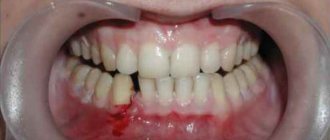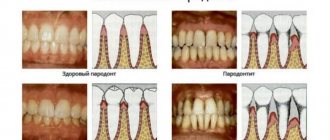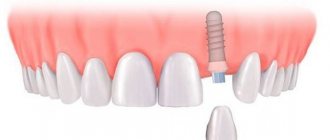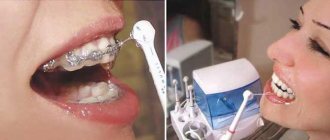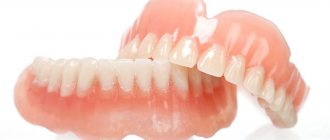Splinting is an effective and, in some cases, the only way to eliminate tooth mobility and prevent their loss in periodontal diseases and jaw fractures.
The essence of the procedure is to fix “sick”, mobile teeth and transfer the chewing load from them to healthy ones, creating conditions for the healing of soft or bone tissues.
To do this, they cover with special tires:
- lingual (inner) surface of the lower front teeth;
- frontal (external) – when splinting the upper anterior crowns;
- chewing surface of lateral teeth and molars;
- ground abutment crowns – in case of partial edentia (absence of teeth).
Duration and results of the procedure
During the installation process, dental splints are fixed with photopolymer fillings matched to the color of the teeth, therefore:
- look aesthetically pleasing and almost invisible in the mouth;
- do not cause discomfort;
- cover the tooth by only 2 mm and leave access for hygienic procedures and therapeutic intervention.
Splinting is indicated for atrophic processes in the periodontium and the resulting mobility of teeth, bleeding and gum recession (enlargement of pockets and exposure of tooth roots). It is also used for bruxism and jaw bone fractures.
Duration of treatment
Splinting structures are installed:
- temporarily (from 6 months to several years) – as a preventive measure after treatment of periodontal diseases;
- on an ongoing basis - for chronic periodontitis, which is accompanied by tooth mobility and atrophy (thinning) of the alveolar processes in their roots;
- for a period of 3 to 6 weeks if jaw fractures are diagnosed based on X-ray results.
Removable and non-removable dental splinting
The more healthy, “not loose” teeth are involved in splinting, the higher the effect of the procedure. Affects the course of treatment and the type of splint.
The most effective are considered to be non-removable splints - tapes and threads made of high-strength materials, as well as steel arches that connect 4, 8 teeth, and sometimes the entire row of teeth (arched splint).
Advantages of fixed tires:
- are securely attached to the teeth and limit their mobility;
- distribute the chewing load evenly;
- indicated for severe, chronic form of periodontal disease with atrophy of the alveolar processes up to 30% of the length of the dental roots;
- allow you to “unload” the periodontium as much as possible, which promotes its rapid healing.
Removable splints are an ideal solution for people with partial edentia, since prosthetics and implantation for periodontal lesions are contraindicated.
Pros of removable tires:
- do not interfere with surgical intervention;
- are easily removed and facilitate oral hygiene, which is extremely important for periodontitis;
- perform the functions of dentures and transfer the load to healthy supporting teeth.
How is the effect achieved?
Looking at the photo of splinting teeth with fiberglass, you can see that the group involved in the splint is one whole and absolutely motionless... and this effect is not deceptive. The fact is that when illuminated, the fiberglass tape becomes very hard, and its fixation on the teeth makes it possible to redistribute the chewing load between the teeth. Even if the patient bites on one tooth, the load will be distributed over all teeth that are involved in the splint. This approach eliminates the loss of contact between teeth, which is observed with periodontitis. With it, each tooth receives maximum load, which leads to even faster progression of the disease. Thanks to the use of fiberglass tape, the process of bone atrophy slows down and often stops completely.
Teeth splinting technique
Installation of splinting structures is indicated only after elimination of the inflammatory process in the soft tissues of the gums. Usually this is preceded by laser therapy and orthodontic correction.
When choosing the type of splint and splinting method, the dentist analyzes:
- X-ray data;
- degree of tooth mobility;
- features of bite;
- the presence of bleeding gums and their recession in the root zone of the teeth.
In 70% of cases of periodontitis, cable splinting is used. This is a fast, inexpensive and aesthetic method using high-strength dental tapes, which are fixed around the perimeter of the teeth and covered with photocomposites.
How does the cable splinting procedure work?
- The “working area” is isolated from saliva using a rubber dam (soft, sterile pad).
- The surface of the teeth is cleaned of hard deposits and treated with 40% phosphoric acid.
- At the site where the splint is applied, a furrow up to 0.5 mm deep is formed with a bur.
- Dentin bonding (dental glue) is placed into the cavity and a splint tape is attached to it.
- A light-curing composite is applied pointwise over the structure and “illuminated” with a halogen lamp.
- Remove remaining material with a grinding bur.
Cable splinting practically does not interfere with articulation and does not cause discomfort when chewing. According to patient reviews, final adaptation to the splint occurs 10-14 days after the procedure.
Cable splinting of teeth
Splinting teeth with fiberglass
The most popular and practical materials for splinting are fiberglass tapes and strands because they:
- biocompatible with tooth dentin;
- have high strength;
- do not interfere with aesthetics when splinting anterior teeth;
- inexpensive.
True, the service life of a fiberglass structure is about 3 years. Therefore, for permanent permanent splinting for chronic periodontitis, dentists recommend installing splints made of aramid fibers.
Aramid thread is 8 times stronger than piano steel, is also compatible with natural bone tissue and is affordable. The only drawback is the color of its fibers (golden, brown), which, in principle, only matters when splinting the front teeth.
Splinting teeth with fiberglass
Splinting with clasp dentures
Clasp dentures are an excellent alternative to traumatic coronal splinting because:
- serve as a replacement for missing teeth;
- allow you to avoid the procedure of depulping and turning;
- easy to remove and clean;
- distribute the load in the dentition.
The clasp prosthesis is based on a metal arch, which tightly clasps the crowns of the teeth in the root zone and, thereby, limits their mobility. Thanks to this feature, clasp splinting is successfully used for focal periodontitis.
Splinting clasp prosthesis
For fractures
The main task of splinting structures for fractures is to connect and fix the damaged jaw bones. For this purpose, single-, double-sided or double-jaw splinting is used:
- metal hooks or rubber loops are installed in the place prescribed by the doctor;
- a wire is passed through them and the damaged parts of the jaw are connected;
- splinting material is fixed to molars or healthy areas of the jaw bone.
The maxillofacial surgeon prescribes the splinting method after studying a panoramic photograph of the jaw. Depending on the type and complexity of the fracture, the time of wearing the splint ranges from 21 to 40 days.
Splints for the treatment of jaw fractures
How to apply a splint for a jaw fracture
All manipulations to install the fixation structure are carried out under local anesthesia.
Unilateral splinting
An effective method of splinting for a fracture of the lower jaw is unilateral fixation. To create immobility, structures made of curved wires are used. They are fixed at the base of the crown of the chewing teeth to fix the jaw in an anatomically correct position.
The method partially preserves physiological mobility, which is necessary for chewing. This is a gentle treatment method that does not cause severe discomfort to patients.
Double-sided splinting
The splint is installed on the upper and lower jaw. To reposition bone fragments, smooth staples or splints with a spacer bend are used. The structure is attached using hooking loops and has intermaxillary rods.
Such immobilization agents are prepared for each patient separately. When manufactured correctly, the tire should:
- pass along the line of the necks of the teeth;
- touch each tooth;
- exactly repeat the curvature of the bite;
- should not injure the gingival papillae;
- should not spring.
For double-sided splinting, a Vasiliev splint is also used - a tape with hooking loops made of stainless steel.
Double-jaw splinting
To simultaneously fix both jaws, paired elements are used - structures with hooks and rubber rings to tightly press the bones and tighten them.
In order to treat displaced fractures, patients are fitted with structures with spacers. They prevent deformation of the dentition and the jaw itself. Elastic ligatures are safe, reliable and easy to apply to injured areas.
Indications for bilateral immobilization
- complete fracture of the upper jaw;
- multiple fractures;
- risk of intracranial complications.
Before splinting
Before therapeutic immobilization, a thorough diagnosis is carried out to determine the degree of jaw destruction and the integrity of the teeth.
Cases in which teeth can be removed:
- pronounced loosening of the tooth with a fracture of the root zone;
- damage followed by purulent inflammation;
- tooth that cannot be aesthetically restored;
- driving into the jaw;
- if teeth interfere with the installation of tires.
If it is possible to save their teeth, patients undergo a jaw bypass procedure. The dentition is fixed using devices that allow them to remain immobile for a long time. If the tooth roots move away from the sockets and do not adhere tightly to the soft tissues, this is a direct indication for bypass surgery.
Materials used
In most cases, ligature wire made of stainless steel and copper is used. This is an accessible and inexpensive way to restore bone integrity.
If the fragments are displaced, osteosynthesis tools are used - mini-plates, screws, screws, staples with specially specified properties. For comminuted fractures of the lower jaw, quick-hardening plastics are used.
Possible complications
While wearing a splint, some patients experience complications:
- inflammation of the gums caused by lack of proper oral hygiene;
- pulpitis due to trauma to dental tissues when creating a groove for the splint;
- breakage or “unsticking” of the structure as a result of the use of low-quality composites.
Overall, dental splinting is an inexpensive and accessible procedure. Therefore, it is worth entrusting it to a more qualified specialist and not saving on photopolymer materials, the “shelf life” of which, depending on price and quality, varies from 5 to 15 years.
This will allow you to avoid complications during treatment, limit yourself to 1-2 visits to the dentist and forget about the problem of tooth mobility forever.
Indications for the procedure
Often people turn to the dentist for splinting as a result of mechanical damage or to correct the consequences of periodontitis.
But in addition to this, a specialist may be required in the following cases:
- The dentition is damaged or severely displaced.
- Damage to oral tissues.
- After wearing braces.
- Non-standard arrangement of teeth.
- Severe detachment of the gums, which exposes the roots of the teeth.
- The presence of tartar and heavy plaque, which is impossible to cope with on your own.
Only a dentist can prescribe a splinting procedure. But first, he needs to study the condition of the oral cavity in detail, based on X-ray data and visual examination.


